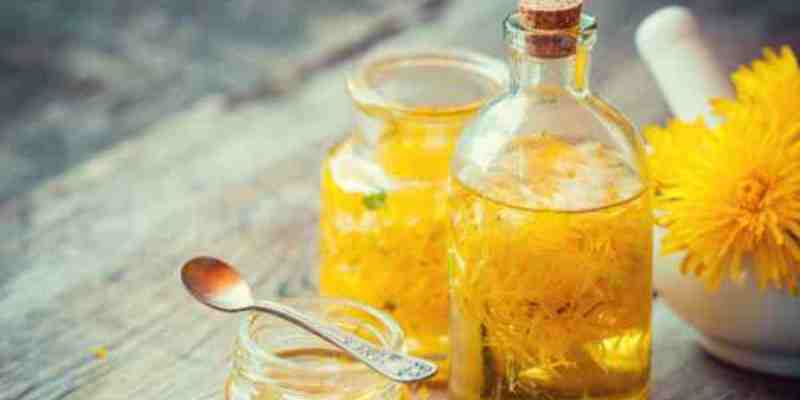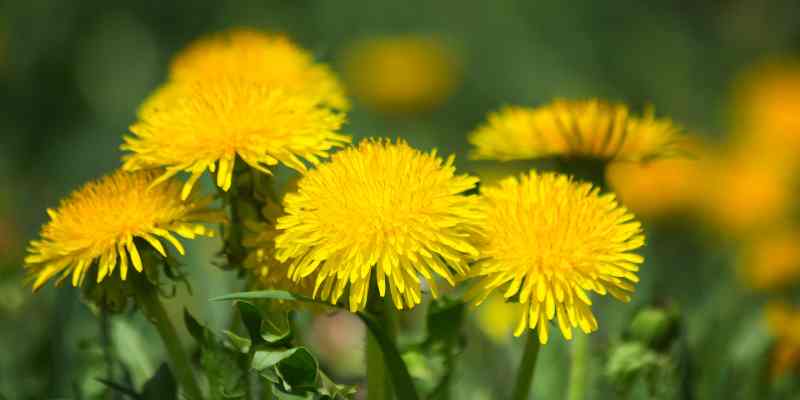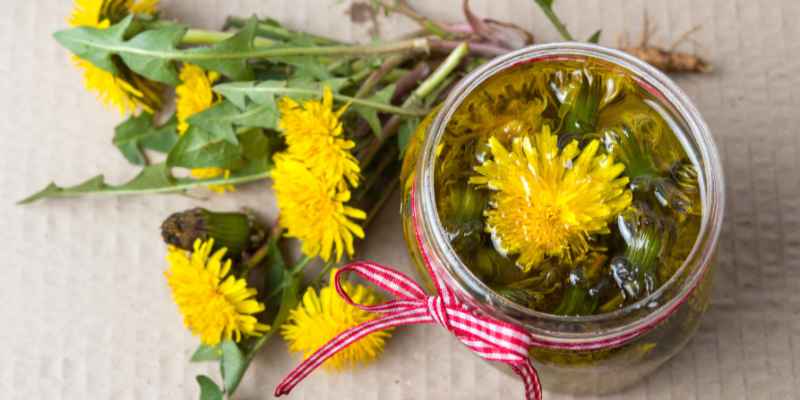The dandelion, which cheerfully reappears on our short grass meadows from March onwards, may be a source of annoyance for some, but it can transform into the perfect flower for a homemade beauty treatment! It is used to prepare an oil or flower macerate, particularly beneficial at this time of year.
With its beautiful golden hue, the often-unwanted dandelion proves to be not only an edible plant (all its parts, from the root to the flowers, can be used for infusions, vinegars, delicious salads, or a charmingly named jelly called cramaillote), but its flowers also hide numerous benefits for the skin. Discover in this tutorial how to make your own homemade dandelion oil: a simple recipe that takes just a few minutes!

Dandelion Oil Macerate: Benefits and Uses
We should actually refer to it as an oil macerate, the correct term, which involves steeping plants in a neutral vegetable oil for several weeks to extract their natural compounds and active ingredients. The most well-known are St. John's wort for relieving muscle pain and calendula (the marigold in our gardens), but dandelion oil is another macerate worth discovering, made by steeping the flowering tops. These maceration oils are always reserved for external use, in skincare and massage.
What Is Dandelion Macerate Used For?
The benefits of dandelion roots and leaves in phytotherapy are well-known (reputed to be rich in inulin and polyphenols), but the active compounds in dandelion flowers also have their say! Dandelion flowers contain compounds such as flavonoids, carotenoids, and phenolic acids. They are reputed to be regenerative for the skin, as these compounds are believed to have antioxidant, anti-inflammatory, and hydrating properties.
Much like St. John's wort, with the added advantage of not being photosensitising, dandelion macerate is primarily recommended for:
- As a massage oil to relieve muscle tension and joint pain.
- As a relaxing oil for stress relief.
- To naturally treat sunburn.
- As a topical treatment to soothe eczema, acne, and psoriasis.
- You can also use this care oil as an ingredient to incorporate into restorative balms based on coconut or shea butter, for dry or chapped skin, as it has hydrating properties.
- Dandelion is even known for its brightening action. It was once used to supposedly fade freckles!
Important! Note that some people allergic to Asteraceae may not be able to use it.

When and How to Harvest Dandelion Flowers?
Harvest the flowers in the morning during spring, as soon as they are fully open and the dew has evaporated. Dandelion (Taraxacum officinale) grows on our short grass meadows in spring, it's best to pick them from your own garden rather than from meadows or roadside edges where they may be contaminated by animal waste or nearby pesticides.
How to Prepare a Dandelion Oil Macerate?
The dandelion oil macerate is essentially a cold infusion of the flowers in a neutral oil. As with all homemade care preparations, be meticulous about cleanliness and sterilisation of the equipment used.
Ingredients and Equipment for Two 200 ml Bottles of Dandelion Oil
- Freshly picked dandelion flowering tops (or dried flowers from an organic shop or herbalist), enough to fill your jar (between 100 and 150 g)
- A good neutral organic vegetable oil* (sunflower oil, olive oil, almond oil, grapeseed oil, jojoba oil, or sesame oil)
- A transparent glass jar of 500 ml with a lid for maceration (recycled or like a jam jar), or ideally a jar without a lid + a piece of gauze, linen cloth, or coffee filter and string
- A perfectly clean wooden spoon
- String or a large elastic band
- Opaque 200 ml bottles with lids
- A fine sieve or cheesecloth
- A pretty label
Dandelion Oil Recipe
- Sterilise your maceration jar.
- Harvest the dandelion flowers, keeping 0.5 cm of stem.
- Dry them flat for 24 hours on a clean cloth in a warm room, to allow any small insects to leave and to remove residual moisture.
- Fill the jar three-quarters full with flowers, then cover them completely with oil. Press lightly with a wooden spoon to remove air bubbles. Stir gently. Add more oil until the jar is full.
- Close the jar with gauze or a piece of cloth and secure it with an elastic band or string.
- Place the jar in a room at room temperature, in sunlight, for example, near a window.
- The maceration should last two weeks, ideally three **: stir every two days with a clean spoon. Check for mould or fermentation (especially if the flowers are fresh). Prolonged maceration allows for better extraction of active compounds.
- After this maceration period, filter the liquid with a fine sieve, then a second time with the sieve lined with cheesecloth, into a clean bowl. The liquid should be perfectly clear.
- Pour the resulting macerate—now a beautiful golden colour—into an opaque bottle, which should also have been sterilised with boiling water. Seal tightly with the lid.
- Label with the date.
* You can choose to mix oils, combining their benefits. If you prepare your oil macerate primarily for use as a massage oil for muscle pain, opt for sesame oil, known for its anti-inflammatory properties. If it's for incorporating into balms or creams for the skin, choose almond oil, jojoba oil, or sunflower oil. Olive oil is one of the most stable for optimal preservation.
** If using dried flowers, infuse them for four to five weeks.

How to Store Dandelion Oil Macerate?
Store your bottle of dandelion oil in a dark place at room temperature, ideally a cool pantry. A dark-coloured bottle ensures better preservation. To guarantee perfect preservation, two things are crucial during preparation: no damp flowers at the start, and all flowers must be submerged in the oil! Finally, as mentioned earlier, the base oil plays a role in shelf life: olive and jojoba oils are the champions.
This homemade dandelion macerate only keeps for a few months (between 6 and 9 months), as it tends to go rancid quickly. So, it's best to remake it every spring if you enjoy it. If the bottle emits a sharp or suspicious odour? Do not use it.
Feel free to share your own homemade plant oil recipes in the comments!
































Comments